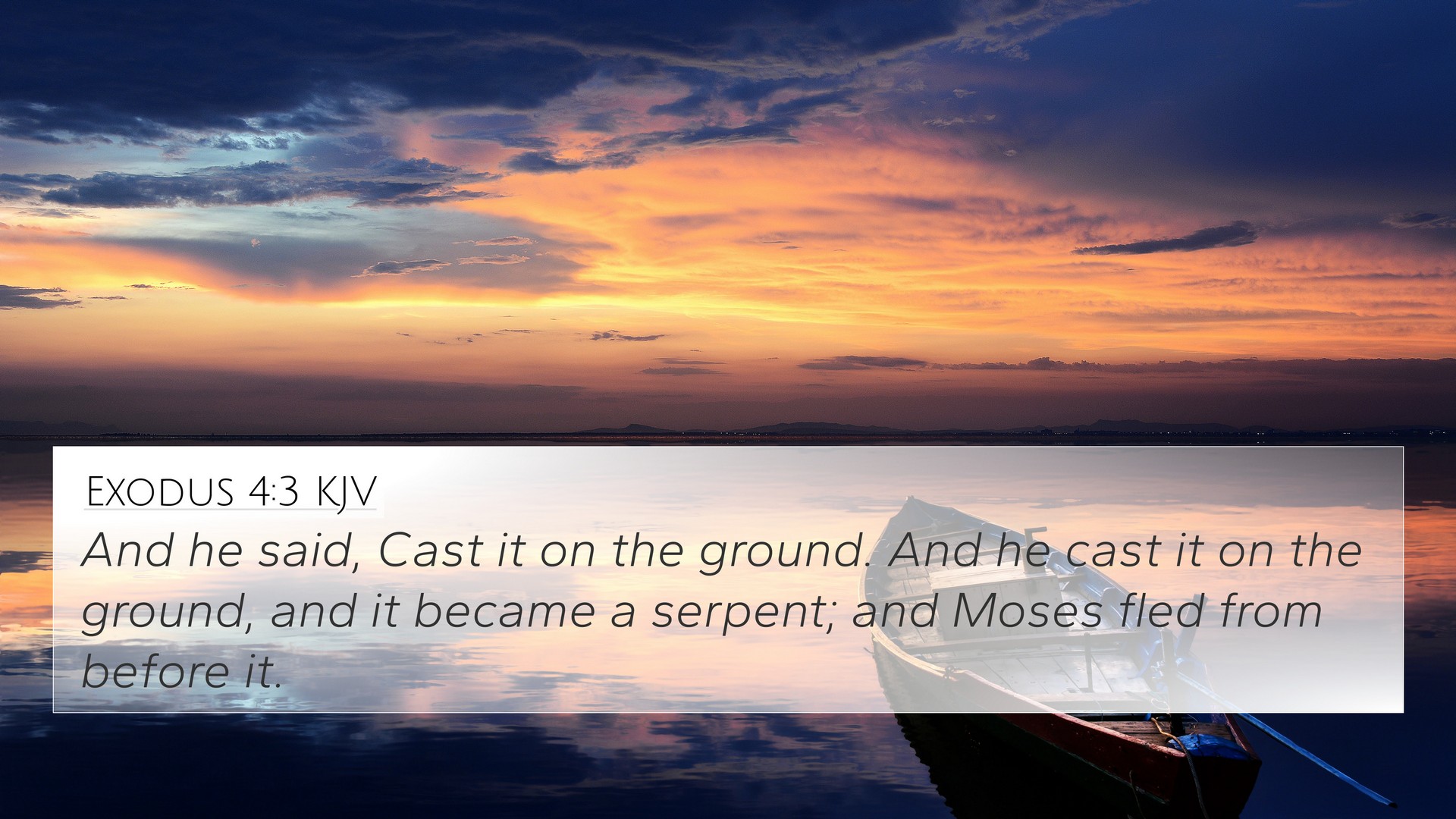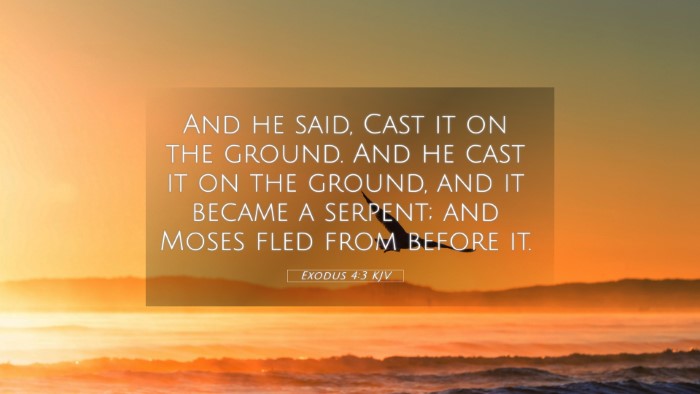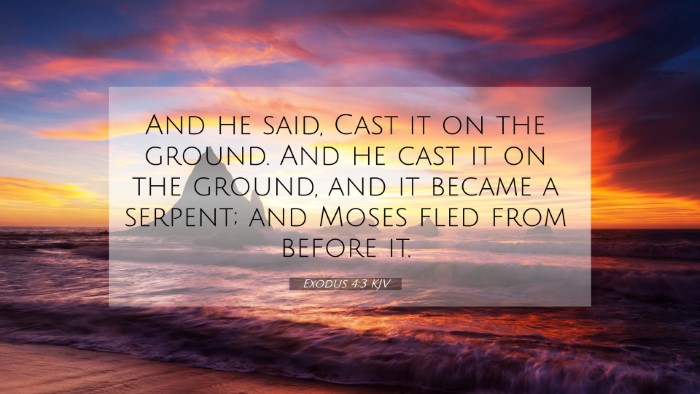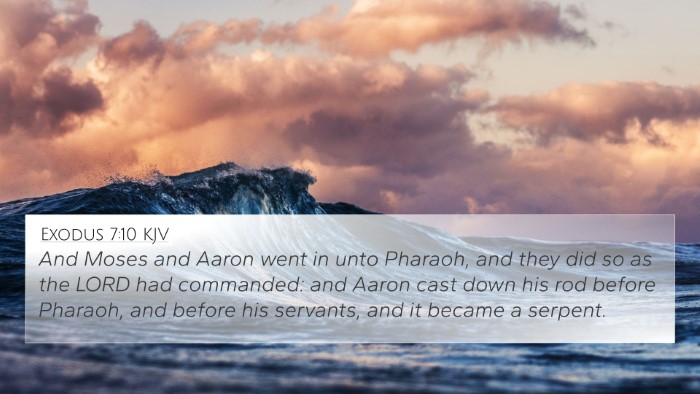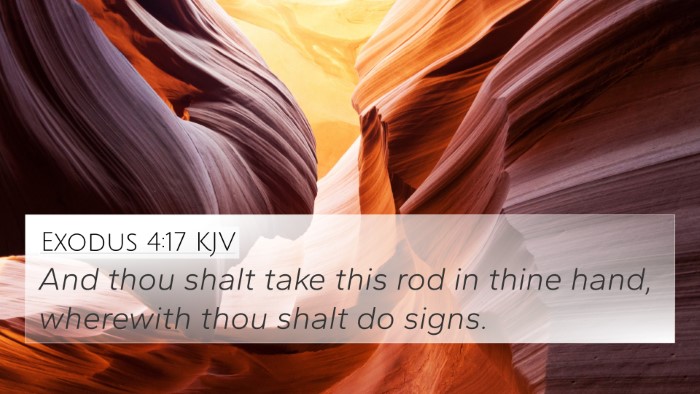Understanding Exodus 4:3
The verse Exodus 4:3 states, "And He said, 'Throw it on the ground.' So he threw it on the ground, and it became a serpent; and Moses fled from it." This moment captures an essential part of God's interaction with Moses and serves as a profound lesson in faith, obedience, and divine power.
Meaning and Interpretation
Exodus 4:3 is significant as it marks the beginning of a series of miraculous signs that God gives Moses to prove His power and authority before Pharaoh and the Israelites. Here are some key insights drawn from Public Domain Commentaries:
- Matthew Henry:
Henry emphasizes that the act of throwing the rod down shows the necessity of obedience and illustrates how God can take ordinary objects and turn them into instruments of His will. The transformation of the rod into a serpent is not only a demonstration of God's power but also serves as a metaphor for the fear and wonder of God's presence. Moses' reaction, fleeing from the serpent, highlights human fear in the face of divine authority.
- Albert Barnes:
Barnes notes that this event foreshadows the future signs and wonders that God will perform through Moses. The transformation into a serpent symbolizes chaos and danger, entities that are conquered by divine intervention. The lesson here stresses that God equips His chosen leaders with signs to validate their mission and instill confidence in others.
- Adam Clarke:
Clarke observes that the serpent ('nahash' in Hebrew) has various connotations in scripture, often representing evil or sin. By turning a simple shepherd's staff into a serpent, God illustrates that He has authority over all creation, even over elements considered dangerous. This act invites both fear and reverence and sets the stage for the subsequent miracles Moses will perform.
Thematic Connections
Exodus 4:3 lays the groundwork for various themes throughout the Bible, including:
- Divine Authority: The act of transformation emphasizes God's sovereignty over nature.
- Fear and Faith: Moses’ initial fear teaches believers about the natural human reaction to the extraordinary, and the call to trust in God.
- Preparation for Mission: This experience prepares Moses for the challenges ahead as he confronts Pharaoh.
Cross-References
Exodus 4:3 connects with several other Bible verses that enhance its meaning:
- Genesis 1:26-28 – God's authority is established from creation.
- Genesis 3:1 – The serpent's association with temptation and evil.
- Exodus 7:9-12 – Further signs demonstrating God's power through Moses.
- Isaiah 43:10-13 – Establishing God's sovereignty and foretelling deliverance.
- Matthew 10:16 – “Be wise as serpents...” connects the serpent's wisdom with the need for caution in ministry.
- Mark 16:17 – Signs that will follow believers, linking the theme of divine signs throughout the New Testament.
- Revelation 20:2 – The binding of the serpent, showing God's ultimate victory over evil.
Conclusion
Exodus 4:3 is a significant scripture that illustrates powerful themes of obedience, fear, and the transformative power of God. In studying the connections between Bible verses, one can deepen their understanding of God's interaction with humanity through signs and wonders, thus enhancing their faith and providing insightful perspectives for biblical study.
Further Study Tools
For those interested in exploring cross-references and connections between Bible verses more deeply, several tools and resources can assist:
- Bible Concordance
- Bible Cross-Reference Guide
- Cross-Reference Bible Study resources
- How to Use Bible Cross-References tutorial
- Comprehensive Bible cross-reference materials
FAQs
Below are some frequent questions related to Exodus 4:3 and cross-referencing in general:
- What verses are related to Exodus 4:3?
- How do Exodus 4:3 and Matthew 10:16 connect?
- What Bible verses support God's sovereignty as portrayed in Exodus 4:3?
This analysis encourages deeper engagement with scriptures and helps believers recognize the interconnectedness of God's word throughout the Bible.
